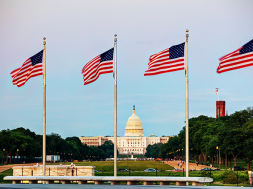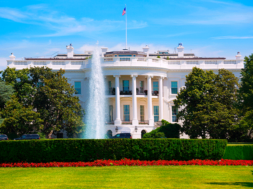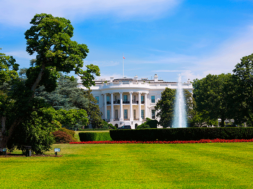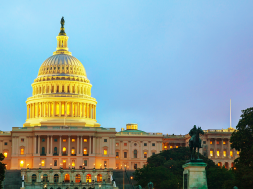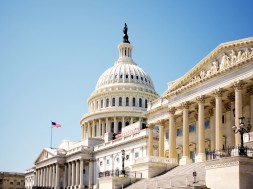
Whether it’s a Wave, Ripple, or Undertow … Position Your School to Handle all Political Currents
By Aaron Shenck, Executive Director, PAPSA
Will the 2018 midterm elections be a “blue wave” of Democrat wins? Or will it be a “red wave” that holds or strengthens current Republican majorities across the country? Or will it be a purple ripple with mixed results for both political parties?
Will this November’s elections bring continued control of both chambers of Congress by one party or will it bring divided government with different parties controlling the House and Senate?
What effect will all of these results have on the President’s ability to govern over the next two years? How will this election tee up the 2020 presidential race?
These questions will dominate cable news stations, social media, kitchen table conversations and bar room discussions from now until the evening of Tuesday, Nov. 6, 2018, when polls close and election results come in across the country.
More importantly, why do these questions matter to your school? What can you do to help leverage electoral outcomes to help your school? And what can you do to set your school up with strong political relationships and support in your community?
Give me the next seven(ish) minutes of your time, read this article, and hopefully, some of these questions will be answered.
What does your 2018 election “crystal ball” say?
First, I don’t own a crystal ball, or will I try to fake that I know for sure what the results will be. Second, nobody on TV or social media can definitively know what the results of November 2018 midterms will be. However, here is my best educated guess of what the results may look like. If I am right, feel free to buy me a beer at the next CECU Convention in New Orleans in June 2019, or PAPSA Conference in Lancaster, Pennsylvania in July 2019. If I am wrong, we can still have a beer together, and you can remind me how wrong I was.
I anticipate the U.S. Senate will remain in Republican control. They currently have a very narrow 51-49 seat lead. It is likely they will hold this number, or potentially add a small number of additional seats to pad their majority. Since U.S. Senators only run once every six years, many incumbent senators are not on the ballot this year. Most seats on the ballot in 2018 are currently held by Democrats, and more importantly, about 10 of those incumbent Democrat Senators on the ballot are running in states won by President Trump. A much smaller number of seats on the ballot this year are currently held by Republicans, and only a very few of those seats are in states that Democrats have a realistic chance.
Given the races on the ballot this year, Democrats have to defend a lot more turf than Republicans, and many of the playing fields where they are defending their turf are tinted red. Democrats would need more than a blue wave, more like a blue tsunami, to win the Senate back under these conditions. Even if they do manage to pick up one seat in the Senate and make it 50-50, Republicans still have Vice President Pence as a tie-breaker for votes in the chamber.
Most analysts (not all) probably agree the U.S. Senate will stay Republican. However, the U.S. House is much more challenging to predict.
Historically, if Congress is controlled by the same party as the President, that party loses a lot of seats in the midterm elections. This historical trend favors Democrats this year. However, it is also historical precedence for the party in power during an economic boom to get credit at the polls and win re-election. This historical trend favors Republicans this year.
Other factors to consider are Democrats have been energized for the 2018 election since the day Trump was inaugurated. Polling data has also leaned Democrat for a while, but Republicans have made some recent gains in polling data likely from an energized base that is upset over the way they believe Senate Democrats managed the Justice Kavanaugh nomination. In addition to these factors, new congressional maps have been issued in a few districts that significantly favor Democrats, a lot of outside money pouring into competitive districts of both parties across the country, personal and legal problems with some candidates in a few races, and many other wild variables.
Put all of these factors into a cocktail shaker, stir it up, and it is very difficult to know for sure what will pour out. However, I predict Democrats will flip seats that are currently red and turn them blue. I believe Democrats will make gains in the U.S. House – likely significant gains. However, will they flip enough seats to gain control of power in Congress? I am not sure. They need to flip 24 seats nationally from Republican to Democrat while holding all of their current seats. This is doable this year for Democrats, but certainly not easy or guaranteed. Thus, it is likely Democrats will either gain control of Congress – or – Republicans keep control of Congress with a much narrower margin.
Why is this important for my institution?
The results of these elections will not only determine control of the House and Senate, but also what party controls the House Education & Workforce Committee and the Senate Education (H.E.L.P.) Committee. The Higher Education Act (HEA) is still due for reauthorization, and these committees control its passage and what will end up in the final bill.
Depending on what parties control these committees, they will significantly shape what the next HEA Bill will look like. Will the bill simplify FAFSA, provide Title IV funding for more short-term programs, provide for Year-Round Pell, reinstate Ability-To-Benefit for students entering career and technical training without a high school diploma or GED, prohibit over-regulation of schools, provide for more common outcome metrics across all higher education sectors, and other provisions that are supported by career schools? Or, will the HEA contain provisions that codify Gainful Employment and other burdensome regulations into statute? Turn the 90/10 calculation into 85/15? Remove veterans from 90/10 calculations? Maybe it will provide for “free” public colleges? Or other problematic proposals that concern many of our sector’s schools.
The results of the 2018 midterm elections, who controls the chambers and committees, and what members are placed on the committees will determine the answers to many of these questions.
In addition to the HEA, the next Congress will also consider Pell Grant and other Title IV funding amounts, tax laws, economic policies that impact the workforce, and many other issues that affect schools either positively or negatively across the country.
What can I do between now and the November election?
First, make sure you vote in November. If you are not already registered, check with your state election laws to see if you still can register in time for this election. If it is too late for this year, register for the next election. Also, to the extent you are comfortable doing so, make sure your school staff are knowledgeable on the issues that impact your school and encourage them to vote as well.
Research where the candidates are on issues that affect your school. If you aren’t sure, ask them or their staff. Make sure the candidates know where you stand on these issues. Also, don’t be afraid to ask your state association or CECU whether a candidate is supportive of career education and our sector or whether they are not.
Finally, please consider inviting candidates to your school if possible for a campus tour prior to the election. This can be a “win-win” for both the school and candidate. The school will get a chance to showcase their programs, student outcomes, job placements, community involvement, success stories, and more to the elected officials or candidates. The elected official or candidate will likely leave the school with a much greater appreciation of skilled trades, career education, your school and the sector. Plus, a tour or visit to a school can benefit them because it gives them a chance to meet many constituents/voters (school leaders, faculty, students, and employers) in a positive and controlled environment. Also, if the elected official or candidate is open to it, consider press releases and social media post about the visit that will give both the school and candidate additional exposure in the local media.
What can I do in the short run after the November election?
Follow up with the winners of the races in your school campus locations. Congratulate them on their win. If they are new to office or have not already been to your campus, please invite them to your campus for a tour.
There are currently 56 open seats in Congress, where there is not incumbent on the ballot. Plus, there is a strong likelihood that at least a dozen incumbents or more could lose their seats after this election. Thus, it is likely there will be at least 70 new Members of Congress elected this year. Every one of them needs to learn the many positive aspects of our sector and the success of our schools and students as soon as possible, before they hear misinformation or a critic poisons their view.
What can I do in the long run?
Having strong political relationships and standing in the local community is critical for a school to succeed and grow. However, this is often not attained in one election or in a single year. It can take years to develop the political support necessary for a school to thrive in the long run. The rest of this article will give schools advice on how to be “grassroots” advocates for their schools in their local community and some strategies to accomplish this.
The first question schools may ask is, “What offices or public officials should I focus my advocacy on?” The answer should be all of them. Although national elections get a lot of the attention and are certainly important to schools because of federal issues like the Higher Education Act and Title IV funding, state and local public officials must also be part of your institution’s political efforts. States typically authorize or license schools and approve their programs and credentials, they also often have state financial aid or other funding pools that students or institutions qualify for, plus state tax and labor laws, and a variety of other state policies affect institutions every day. Local governments approve zoning, construction and transportation projects that could impact schools, local taxes, community development funding, and much more.
Institutions should recognize that all elected officials – federal, state, and local – make decisions that impact their schools and students, so all of these officials should be part of a school’s grassroots advocacy efforts.
This also includes officials of both political parties. It is critical schools are forming relationships and growing awareness of their institution with both Democrats and Republicans.
It is also extremely important that schools do not ignore, but rather seek to build relationships with the staff of U.S. congressman, state lawmakers, and/or local officials. Staff have a significant amount of power inside many public offices. They often write the legislation or amendments their boss introduces, their policy recommendations are usually agreed-with by the elected official, they maintain their boss’ schedule, perform constituent services for them, and are the front-line contact person from their office to executive agencies (like the Department of Education). Staff is also easier to reach sometimes. Finally, many staff are ambitious politically so today’s staffer may become tomorrow’s mayor, state lawmaker or congressman. If you build relationships early with them, those relationships are likely to carry forward when they become future public officials.
Now that you know who to communicate with, here are some strategies and ideas to consider to help with advocacy:
- School tours – As mentioned earlier, getting a public official (or staff) into your school for a tour is a critical component of building local political support. If they have not seen firsthand your school’s programs and successes, it makes the rest of your advocacy more difficult.
- Research candidate’s interests – Before you schedule a tour or do any outreach to a public official or candidate, do a little research on them first. Learn their motivations and driving interests, then schedule a tour or your advocacy around their interests. For example:
- If they are a veteran, host a student veteran roundtable with them at your school;
- If they serve on the Transportation Committee of the U.S. House or state house and if your schools has trucking or other transportation logistics programs, then develop their visit around those issues;
- If they were a healthcare worker before they became a public official, then showcase your school’s nursing or allied health program if you have one; or
- If you learn they are a foodie and your school has a culinary arts program, then have them tour this program and maybe treat them to a nice student-prepared meal.
Do your research on the public official, be creative, and utilize your school’s assets.
- Graduation ceremony speakers – One of the best ideas to help build political relationships is to invite a public official to be a graduation speaker to your school. They will see firsthand the excitement students (and their families in the audience) have for your institution, and it should leave them with a positive impression of career education and your school. Plus, the public officials benefit from it because they can speak and get their name out in front of hundreds of constituents and voters in a positive, controlled event.
- Community events – Many career schools participate in various community events. Maybe they are providing free dental clinic services in the community, or free cosmetology services, or massages, or the school is participating in a toy drive. Whatever the event is, send public officials an invite. Even if they can’t make it, they will see the positive impact the school is providing to the community beyond just education.
- Special events at the school – If your school is holding a special event at the institution, don’t be afraid to invite a public official or their staff. It is another way for them to see the good your school is doing for the community and can help build a relationship with the public officials.
- Employer roundtable – Educating and placing students into jobs is what our sector of higher education does better than most others. Having the employers in a community attest to this and provide their perspective to local public officials is very important. Employer roundtables with public officials is a great way to help those officials connect the dots and see how much employers rely on our schools.
- Advisory boards – Some schools have asked public officials to sit on their school or program advisory boards. This is one of the best ways to get public officials to know your school and to have a vested interest in its success.
- Attend political fundraisers – Let’s be honest, running for public office can be expensive and campaigning requires raising funds. One way to help support public officials and to build a stronger relationship is by supporting them financially. This comes at a cost out of your pocket, and not everyone is comfortable with this approach, but it can be an effective way to build additional political support for you or your school.
- Volunteer for their campaign – There are also free ways to help public officials in their campaigns, you can volunteer for them. Maybe it’s by going door-to-door campaigning with them or helping put up yard signs or host them at your house for a neighborhood meet-and-greet. This volunteer time during a campaign is often remembered for a long time by the public officials.
- Newsletters – Work with the public official to see if they would either be interested in putting an article in your school’s newsletter or e-newsletter on an issue important to them or see if they would take an article from your institution on an important issue and put it in their newsletter to constituents. These are simple, free ways for both the politician and the school to leverage each other for public exposure in a positive manner.
- Social media – Same thing applies with social media. Share positive posts with public officials either about your school, your employers, students, or something about the public official. These are easy and free ways to help each other and help build the relationship and connection with your school.
These are just some examples that schools may want to consider to build “political capital” with public officials. However, some advice for schools on political capital. First, use your political capital wisely. Once you have established a good relationship with a public official, be selective when you approach them with an ask or a need for their help. Don’t waste your capital on unnecessary needs for your school and don’t over-ask public officials for assistance on items. Second, build up more political capital than needed. Third, be reasonable in your asks.
If your institution is already politically active or connected, I hope this article may have given you an extra idea or two to help further build those relationships. If your institution has not yet engaged with public officials, I recommend you consider it and hope you have gained some strategies from this article. There is no better time to start than in 2018.
There will always be different waves, ripples, and political currents every election season, sometimes they are blue and sometimes red and sometimes purple. Schools that take the time and effort to build political support in their community will have allies, in the long run, to help their school grow in multiple ways. Schools that do not engage and build local political support in their community will have a tougher time fighting the undertow.
AARON SHENCK currently serves as the Executive Director of PAPSA, which is the statewide association that represents about 100 career and technical colleges and schools primarily throughout Pennsylvania, along with a few members from other states. He has held this position since 2014. He is also currently partnering with Career Education Colleges and Universities (CECU) as their “grassroots” liaison with schools across the country.
Prior to PAPSA, Aaron worked in the Office of the Governor for Pennsylvania under Governor Tom Corbett, where he oversaw legislative and regulatory policies for 10 state agencies under the jurisdiction of the Governor. He also subsequently was appointed by the Governor to work in an agency cabinet-level position to manage Government Relations for the Pennsylvania Department of Education.
Before joining the Governor’s staff, Aaron worked for seven years in the Pennsylvania State Senate, including time as the Staff Director of the State Senate Education Committee. He also worked for four years as a Legislative Aide in the Pennsylvania House of Representatives and two years as an intern with the U.S. Congress.
Aaron holds a Bachelor Degree in Political Science from Millersville State University and a Master Degree in Government Administration from Penn State University.
Contact Information: Aaron Shenck // Executive Director // PAPSA // 224 Pine Street, Harrisburg, PA 17101 // 717-599-8098 // aaron@papsa.org // https://www.papsa.org
